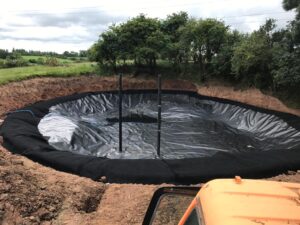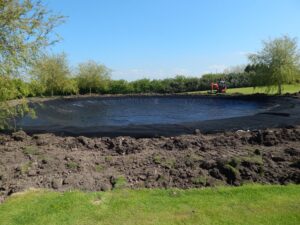Experts are advising farmers investing in slurry lagoon covers to manage their storage carefully to prevent costly crusts forming.
Paul Gaskell, a Manager at Enviroseal Lining Solutions Limited, a company that supplies and installs a range of covers, says covered slurry stores work effectively if treated with a specialist product like SlurryBugs from EnviroSystems. This helps to break down the undigested fibre, creating a more homogenous product.
“Covers prevent farmers from using mechanical means to agitate and stir the slurry, which would usually prevent crusts from forming and fibre from settling at the bottom.
“With many farmers taking advantage of the recent grants, they should understand that unless they use SlurryBugs, invest in equipment to separate the slurry before it goes into the lagoon or install additional agitation pipework, they will lose storage capacity and run into problems over time from crust formation and build up of sediment in the base.
“Often, when a DEFRA grant requires a cover to be installed, one of the conditions is that it needs to be secured so the wind can’t get underneath it, which means it must be placed into an anchor trench. This prevents the cover from being pulled back to be agitated,” he adds.
Current recommendations under the clean air strategy state that all slurry stores must be covered by 2027, with agriculture accounting for 88% of the UK’s ammonia emissions.
Liz Russell at EnviroSystems says managing the slurry under covered lagoons is vital. “Crust issues are a real problem without mechanical agitation. This can cause difficulties with slurry handling by blocking up pumping equipment and reducing storage capacity.
“We have seen an increasing number of calls from farmers with covers seeking help and we have been working with them to help overcome the crusting issues that have occurred,” she says.
One such farmer is Dairy beef finisher Will Hunt from Lydney, Gloucestershire. He encountered crusting issues in his 22,000 m3 lined lagoon after covering it with a gas membrane two years ago.
Before the lagoon was covered, it was agitated using mechanical propellors, which were then changed to liquid mixers when the lagoon was covered. Liquid mixers work by sucking the liquid out of the lagoon on one end and pumping it back into the other end to try and agitate it.
However, for Mr Hunt, the liquid mixer wasn’t enough to keep the crust at bay, and it was only by luck that he had to cut the cover when installing a new piece of apparatus that he became aware of the actual extent of the crusting problem.
“Covering a lagoon makes it impossible for farmers to know what is going on underneath the cover. We couldn’t believe it when we saw a crust over 1.5m deep in some areas. That got us looking at options to get on top of the issue,” he says.
Not only does a crust eat up valuable space in the lagoon, but if it is not removed, it can result in a very costly exercise for a farmer by cutting the cover fully open and employing a digger to extract the crust. “This would be very expensive and could potentially cause damage to the lining of the lagoon. It was something we were keen to avoid,” he says.
Mr Hunt’s lagoon contains digestate from the family’s 1.5-megawatt biogas plant, fed with manure from the farm’s 1,500-head dairy beef finishing herd, crops, and some poultry manure from neighbouring farms. The dry matter of the digestate is slightly higher than that of pure slurry, up at about 7%.
Treating a covered slurry lagoon
The lagoon was treated to its total capacity with 44 x 1.5-kilo bags of SlurryBugs. After only three weeks, there was already some evidence the bugs were working, with bubbles appearing on the lagoon’s surface and the crust breaking down.
“Where we did have the visual assessment through the temporary cut in the cover, we could see activity with bubbles appearing on the surface and the crust cracking. We have now repaired the cut in the cover and left the bugs to work their magic under it to break down the crust,” he says.
Mr Hunt adds, “It’s important that farmers consider how they will manage the crust when they invest in covering their lagoons. SlurryBugs has helped the problem and we are closely monitoring this as we continue to spread. Due to the wet spring, we still have 70% of the lagoon to spread and 80% of our maize to drill; therefore, the benefits of the slurry treatment will continue throughout the summer.”
In addition, Mr Hunt says his investment in the cover has been worthwhile because keeping the rainwater out has improved the quality of the slurry and capacity. “We have also seen an early positive effect on gas production, which is now being circulated back into our AD system for energy and heat production,” he adds.
EnviroSystems latest research has validated the benefits of using SlurryBugs to reduce crust formation.
A two-year study, funded by Innovate UK and conducted in collaboration with Myerscough College, Preston, tested EnviroSystems’ new slurry inoculants, SlurryBugs and SlurryBugs Maintenance, under laboratory-controlled conditions.
“Both of these products are different to our previous slurry inoculants and are unique in the marketplace as they contain five specialised strains of bacteria and fungi that have been found to work most effectively on maximising the complex lignocellulosic biochemical pathways within slurry stores,” explains Mrs Russell.
“The bacteria secrete enzymes which break up the undigested fibre (cellulose and other plant matter), releasing the soluble nutrients and making them available for spreading onto land, producing a more homogenous liquid slurry.
“Our research found that when using SlurryBugs, there was a 29% reduction in crust formation and a 23% reduction when using SlurryBugs Maintenance, giving farmers peace of mind that the crust formation will be minimised and slurry storage maximised,” she says.





